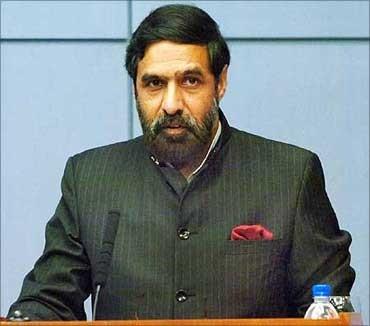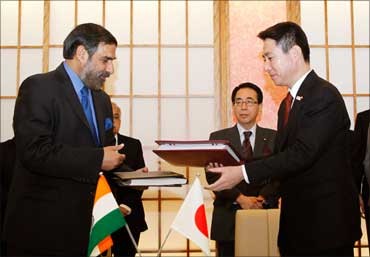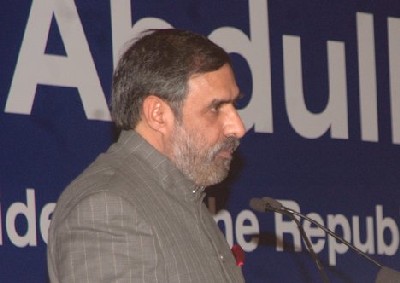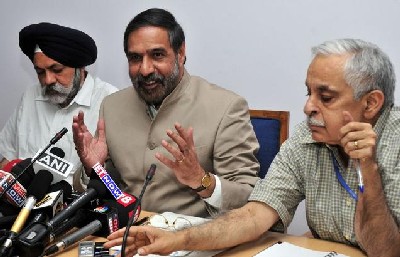Aditi Phadnis in New Delhi
Commerce and Industrial Promotion minister Anand Sharma's rise in government has been dizzying, which is why his current setback is also precipitous. Ahead of the cabinet meeting that took place after Sharma's project -- to ensure the approval of Foreign Direct Investment (FDI) in retail -- was given the thumbs down, his colleagues are asking some searching questions and seeking some hard answers.
Before an issue is brought to cabinet, ministers are expected not just to have done their homework but also to have subjected themselves and their proposal to a rigorous risk analysis before cabinet: would it pass a 360 degree muster?
Sharma says he spoke to Trinamool Congress leader Mamata Bannerjee not just once but several times, following it up with a letter which said the government was taking on board a suggestion she had made, namely that state governments must have the option of getting FDI in retail.
...
This is how a rising star was brought down to earth
Sharma also says he has a letter from at least two Bharatiya Janata Party (BJP) chief ministers dated 2010 supporting FDI in retail. Unfortunately, he has not made the letters public so we have to take his word for it. The existence of the letters has been strongly contested by the two incumbents -- BJP chief ministers of Himachal Pradesh and Gujarat.
Naturally, his colleagues are now trying to figure out the basis for his claim at the meeting that Bannerjee was on board on the FDI-in-retail wagon -- a claim that has not panned out and resulted in the government with substantial egg on its face. In any other country, they say, the minister would have been asked to resign.
Sharma is going nowhere. He is one of Prime Minister Manmohan Singh's most favoured MPs which is why he became cabinet minister in the first place. Because he brings very little to the table in terms of mass politics, many of his colleagues were quite surprised when he became Minister of State for External Affairs in 2006 in a cabinet expansion halfway through the first UPA government's tenure as well as Minister of State for Information a little later.
...
This is how a rising star was brought down to earth
In Indian politics, a frog in a well has a better chance of success than a man of the world. This should not be the case given India's size and growing influence, but it is so.
Sharma opted to swim against the current early in life when he sought an international route to Indian politics -- he caught Rajiv Gandhi's eye when, as president of the Youth Congress, he made non-alignment, racialism and a movement of solidarity against apartheid the cause celebre of the Youth Congress and Parliament.
Rajiv Gandhi had just been made Prime MInister. The Congress had a majority of 400 plus MPs. Sharma was the cynosure of all eyes as he made common cause between India and Africa and made Nelson Mandela a household word. He was 31 when he was elected to the Rajya Sabha from Himachal Pradesh, the state of his birth.
...
This is how a rising star was brought down to earth
This strategy took time to pay off: he was made Chairman of the Indian Anti-Apartheid Movement, but only in 1989. There was no Rajya Sabha seat to be had and he would not have won a Lok Sabha seat because he was unknown in Himachal Pradesh. Untill 1994, he leveraged his Africa connection.
In 1994, he became the Commonwealth Secretary General's observer to the general election in South Africa. Sharma later served on several occasions as the Prime Minister's special envoy to South Africa, Algeria and Tunisia.
His moment of glory was without doubt, the Indo-US Civil Nuclear Agreement. In July, 2006 as he was dispatched to build support for the United States-India nuclear deal, which promised India civilian nuclear technology, Sharma visited Ghana, Nigeria, South Africa and Ethiopia, all International Atomic Energy Agency board members.
...
This is how a rising star was brought down to earth
His efforts paid off when the IAEA approved the deal on 1 August 2008. The next hurdle was the 21-22 August meeting of the Nuclear Suppliers Group, of which South Africa is a member. NSG bylaws forbid the sale of nuclear materials to India, which is not party to the Nuclear Non-Proliferation Treaty.
The NSG met in Vienna to discuss making an exception. It finally did in September 2008. And the credit must go in part to the behind the scenes lobbying by Sharma with the African nations.
This much is true: small or big, every African envoy in town knows Sharma. This has its place in the current woo-Africa policy of the government. So Sharma was made Cabinet Minister for Commerce and Industry in 2009. This time, he was nominated to the Rajya Sabha from Rajasthan six months after he was made minister.
While Sharma has taken time to master the complex world of commerce and trade, all the evidence suggests he still has some distance to traverse.







article